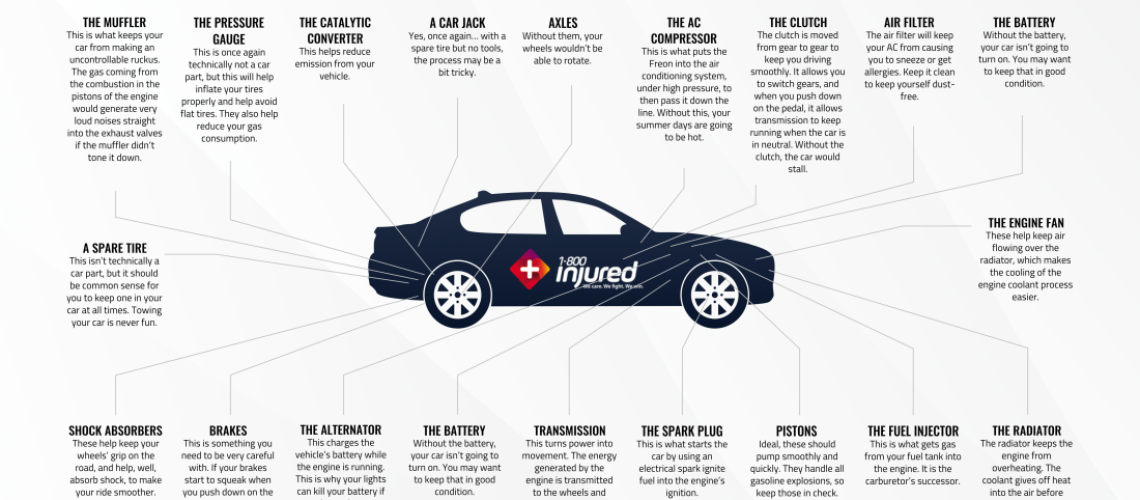

Understanding The Basic Car Features
Are you the type of driver who looks at car specs like “displacement” and “grade” and feels a bit dizzy? Well, you’re certainly not alone. The range of terms in the automotive industry can be intimidating. Car dealers may throw out impressive statistics and jargon about a vehicle they’re trying to sell you, leaving you nodding along while trying to figure out what it all means.
Without the technical know-how, it can be hard for the normal car owner to navigate the market and make an educated choice, getting the best vehicle for a fair price. It helps to have a knowledgeable friend or family member, of course, but it’s always best if you yourself know what you’re getting into.
So consider this article a crash course in understanding car features! As an added bonus, we’ll also give you some Japanese used car specific info.
Maker:
Japanese main car manufacturers
Let’s start with the simplest criteria possible. The maker is the manufacturer of a vehicle, whether they happen to be Honda, Hyundai, Nissan, Ford, GAZ, Skoda, Volkswagen, Toyota…
Too easy? Well don’t worry – things will quickly escalate!
Model:
The model is the specific kind of vehicle that a maker is offering. For example, the “LS 460” is a model produced by the maker Lexus.
Body Type:
Body type, also known as “body style”, refers to the overall shape and function of a vehicle. Some common types of body types are: compact car, mid-size car, full-size car, sports car, minivan, SUV and pickup truck.
Fuel:
Fuel is thankfully a pretty straightforward area. When buying a used car, you more-or-less have two choices in fuel type: gasoline or diesel.
Gasoline is the most common type of fuel. A gasoline engine uses internal combustion to generate energy, as does diesel. Both gasoline and diesel engines use a “four-stroke combustion cycle”, but diesel has higher compression and therefore higher efficiency. A gasoline engines has its advantages though, giving better performance in terms of speed. It also has less upkeep and is generally cheaper to repair.
Diesel has better fuel economy than gasoline because of its energy denseness. Diesel-type vehicles are somewhere in the area of 25% more efficient than gasoline counterparts.
If you buy a car that takes gasoline, then the only choice you’re going to have to make afterwards is whether you’ll buy premium or economy grade fuel.
If you buy a car that takes diesel, usually you will just have one option at the pump, although synthetic diesel is sometimes available in addition to regular diesel.
Still, quite a few people manage to put the wrong fuel type in their car every year. But that’s hardly worth mentioning, because you would never do such a silly thing, right? Of course you wouldn’t!
These days, alternative energy fuels are also gaining ground, although gasoline and diesel continue to remain dominant. Biodiesel serves as a diesel replacement while bioethanol serves as a gasoline replacement.
More and more countries are mixing biofuels with regular ones in order to create a hybrid fuel that is more environmentally friendly. Pure biodiesel and bioethanol fuels generally require special modifications to be made to the vehicles, so they aren’t recommended for the casual user.
Displacement:
“Displacement” refers to the total amount of air displaced by an engine’s pistons. It is usually measured in cubic centimeters (cc), but can sometimes be given in cubic inches or liters.
The displacement of a vehicle will allow you to figure out its engine efficiency in relation to other vehicles in its class. For example, in the compact car market, the 2009 Nissan Tida has a displacement of 1,490 cc, giving it a slight edge in fuel economy in against the 2009 Toyota Corolla Axio, which has a displacement of 1,500 cc.
Mileage (km):
Mileage, or distance traveled in km, is an important thing to consider when buying a used vehicle. It is not, however, the end-all-be-all of used car buying as some people may seem to think – but we’ll get to that later.
Around 200,000 or 250,000 km is commonly seen as a tipping point, where a vehicle starts to noticeably show the effects of wear and tear. Fun Fact: The record for most mileage ever put on one car belongs to a 1966 Volvo P1800s with over 3 million miles, or 4,800,000 km, on it and counting.
The average mileage of a vehicle per year is somewhere in the vicinity of 19,000 km. You can use this figure to do the math on a vehicle’s age and see if it has been “overdriven” (i.e. driven too often) or not.
It’s also worth noting that all miles/km are not the same – 19,000 km on the highway is much better for a car than 19,000 km of city driving, with all its stops and starts. When you look at a used car, the driving condition in which the car was racking up mileage is worth thinking about and asking about.
Low Mileage versus Everything Else
It’s certainly good news if the car you’re looking at hasn’t got many miles on its odometer. But having low mileage itself does not necessarily mean a car is “good” – there may be any number of other considerations that make a low-mileage car unattractive. It may have mechanical defects or an accident history, for example, so it’s important to look at a vehicle as the sum of its parts.
Overall, when buying a used car it’s best to use mileage as another variable in deciding whether a vehicle is a good deal or not. It cannot be seen as a reliable yardstick by itself.
Chassis number
The chassis number is, simply put, a unique code that identifies an individual vehicle. Every single vehicle out there in the world, whether it is a car, truck, motorcycle, moped or backhoe, has a special code on it that no other vehicle has. While license and registration numbers can change from owner to owner, the chassis number stays the same.
Notice how I didn’t use the word “number” to describe the chassis number – that’s because it actually contains letters too. It’s also worth noting that the chassis number is sometimes referred to as a vehicle identification number, or “VIN”.
The chassis number is important for both a potential used vehicle buyer and a used vehicle owner, giving information on place of manufacture, vehicle type and the vehicle’s unique production ID. The chassis number can be found in several places, depending on what vehicle you have. It’s best to start the search by checking in the easiest place: the driver’s side dashboard. This is the most common spot to find the chassis number. If you don’t see the code there, you can try opening the driver’s side door and looking at the vehicle frame where the door closes, also known as the “shut line”. If it isn’t in the shut line, you can try popping the hood and looking at the front of the engine block. Not there either? You might have to stoop down to check in the rear wheel well on the driver’s side.
If you checked all these spots and still can’t find it, a quick internet search for your specific model can usually clear things up. For example, Googling “chassis number Toyota Corolla 2012” instantly solves the mystery of where to look on that model (in that case, you’ll find it on a tamper proof sticker on the “shut line” of the passenger side door).
Found it? Great, now let’s walk you through what all those numbers and letters actually mean.
International vehicles chassis number
The VIN system was introduced in 1954, but it wasn’t standardized until 1981. If your vehicle is older, you may have to do a little detective work to figure out your manufacturer’s chassis number system. Once again, it’s a good thing we have the internet!
If your car is from 1981 or after, the chassis number should always be 17 numbers/characters long. To prevent any potential confusion with the numbers 0 and 1, the letters I, O and Q are generally avoided, although they can appear in the first two positions of the chassis number, which is used to describe countries. These 17 numbers/characters can be broken down into three different sections:
- World Manufacturer Identifier (WMI)
- Vehicle Descriptor Section (VDS)
- Vehicle Identifier Section. (VIS)
The WMI is found in the first three digits, positions 1-3. The first two positions indicate the region in which the vehicle’s manufacturer is located, while the third position is reserved for describing the manufacturer or the specific division at the manufacturer.
So, for example, if the first two positions read anything between JA – J0, the vehicle was manufactured in Japan. If the first three digits read “JA1”
The VDS is found in positions 4-9, and describes the vehicle type. It may also contain information about the car platform and car classification (also known as “body style”). Often, the 8th digit is used to identify the engine type when there are multiple engine choices for one vehicle. The VIS is found in position s 10-17 and identifies the individual vehicle. This is the part of the chassis number that is unique to your vehicle.
Made In Japan vehicles chassis number
It is easy to understand right? Well, until you learn that Japanese cars made in Japan have there own chassis number pattern! In Japan, all Japan manufactured car’s chassis number is divided in 2 parts:
- the model code: common to all cars sharing the same model
- a serial number unique among the cars with same model code
In the following picture, the chassis is JZA80-1004956:
- JZA80 is the model code
- 1004956 is the unique serial number
Navigating the Japanese Auction System’s “Grade” System:
Before they go to auction, Japanese used cars are given a grade by the auction house’s assessors. The grade system is a good way to narrow down your choices, cutting out the bad cars, wrecks or aftermarket modified ones you don’t want, but it cannot be relied upon as a totally accurate measure.
Please find our handy list below:
Grade 7,8,9 or S – vehicle is new, less than 12 months past its first registration date with only delivery mileage Grade 6 – vehicle is basically new, less than 36 months past its first registration date but has slightly more than delivery mileage Grade 5 – vehicle has low mileage (under 50,000 km) and is in excellent condition Grade 4.5 – vehicle is in great condition (maybe a few slight scratches but nothing major) with mileage below 100,000 km Grade 4 – vehicle is in above average condition, has mileage below 150,000 km Grade 3.5 – vehicle’s exterior has noticeable blemishes, like scratches or dents and may need work or new paint; interior may need to be repaired or refurbished Grade 3 – exterior has Grade 2 – vehicle is in rough shape and should likely be avoided Grade 1 – vehicle has aftermarket turbo, automatic transmission converted to manual, or some other modifications RA – vehicle has had minor accident damage and has been repaired R – vehicle has had accident damage that has been repaired, resulting in replacement parts; vehicles in this category require close inspection, as some repair jobs are excellent while others are shoddy *** – vehicle has major damage that has not yet been repaired and is not drivable
Feeling more confident now?
We hope you found at least some of the above info useful. We’ve gone through some of the major vehicle features here, getting from maker to mileage to VIN, with a guide to Japanese used car auction grading thrown in for good measure. Armed with this knowledge, we’re confident you’ll have a much easier time hunting for the ideal used Japanese vehicle.
Add a comment Cancel reply
Categories
- Auction (2)
- Car Models (7)
- Importing Process (5)
- Shipping (3)
- Stock (1)
Recent Posts
About us

Related posts















